September is the month when the summer has officially started winding down, and there is definitely a feel of Autumn in the air. Days are shorter, the weather wetter and garden chores are not as plentiful. That said, there are still some jobs lurking to tempt all of us outdoors. Here are some gardening tasks to keep up with during the month of September.
Quick Gardening Checklist for September
- Pick your autumn raspberries
- Net your ponds before the leaves really start to fall
- Plant spring flowering bulbs
- Begin to reduce your houseplant watering
- Dig the last of your potatoes before slugs damage them
- Clean out your cold frames or greenhouse ready for autumn
- Divide your herbaceous perennials
- Cover your leafy vegetable crops with bird proof netting
- Collect and sow your seeds from hardy annuals
1. Get your lawn Autumn ready
Start to get your lawn ready for the change in season by applying an autumn feed. You should first scarify the lawn then apply a high potassium feed. When it comes to mowing your lawn, raise the blades a bit higher than normal to reduce stress. You could also invest in a mulching mower that spreads mulch over your lawn to retain moisture. September is also the last time of the year that you can effectively add weed killer to your lawn to control perennials such as dandelions and buttercups.
Putting the work in now will pay off in the long term, helping to solve common problems such as fairy rings (fungi), moss and weeds.
2. In the greenhouse
Damping down is generally unnecessary in September as the weather doesn’t usually reach scorching heights, but as we’ve seen this year, it can still reach high temperatures. Keep an eye on the weather just in case and damp down and ventilate as necessary.
Make sure to leave adequate spacing between your plants to reduce the risk of pests or diseases. Regularly check for vine larvae in containers, and start to clean the greenhouse ready for the autumn months.
3. Enjoy your vegetable harvest
September is the time of the year to reap the rewards of all that hard work you put into your vegetable patch, with a long list of fruit and vegetables that are ready for harvesting. Start thinking up recipes for all your onions, sweetcorn, carrots, melon, apples, peppers, courgettes and many more. Anything you can’t eat straight away can be turned into preserves or stored over Winter.
September is also the best time to lift, and pot any rooted strawberry runners to increase your crops next year. It’s also the last chance to earth up your celery. When tackling this task, remember to leave a small tuft of foliage at the top.
Now is the perfect time to sow your winter vegetables to mature for next spring, such as turnips, winter lettuce, and spinach. Just because you are harvesting your crops this time of year, doesn’t mean you can neglect your watering duties. Sticking to a solid watering regime is a great way to avoid diseases and bolting.
4. Houseplants
As light levels drop, you can start reducing your watering schedule to limit the risk of over watering.
Lower temperatures mean you should also start to bring inside any houseplants that have been outside during the Summer. Be sure to check them for pests and infections to stop any problems spreading. Despite the weather getting colder and light levels dropping, there is still the possibility of hot weather, so be sure to shade your houseplants when the weather takes a turn for the better to prevent scorching.
5. Keep on top of general garden tasks
It is important to remember your hanging baskets, as they can start to look a little neglected at this time of year. Keep them well watered and continue to deadhead faded flowers to prolong flowering and prolong your flowering period.
Before the weather starts to get colder, you should bring in your Fuchsia’s and Abutilon to prevent frost damage. Despite bringing in some plants, leave the Dahlias and Cannas out to allow the frost to blacken their flowers before lifting the tuber.
September is a windy month, so it is important to cut back your taller perennials to prevent them snapping off in high winds. You should also start dividing herbaceous plants, whilst also collecting seeds so you can plant them next year.
Deal with perennial weeds by applying weedkiller containing glyphosate. This will make sure that that troublesome roots are killed. When using weedkiller protect nearby plants with plastic sheeting.
When it’s too wet to get outside it’s time to settle down and browse online the wide variety of spring bulbs that are perfect for getting in the ground now to ensure colourful displays from February through to late May. Choose from hyancinths, daffodils, crocus, tulips and Allium’s.
6. Protect your structures from Winter weather
With wet Autumn weather just around the corner, it’s a good idea to take advantage of dry weekends to paint fences, sheds and other wooden features with a preservative. Those that are water-based are kinder to the environment. Try to avoid using older oil-based products (such as creosote) that are no longer approved for domestic use.
If your shed roof has a leak, add getting that fixed to your task list before the rains arrive.
Should you need a hand with garden landscaping and general maintenance, Thames Valley Landscapes can help. Call us on 01628 629 720 for creative ways to make the most of your garden all year round.


